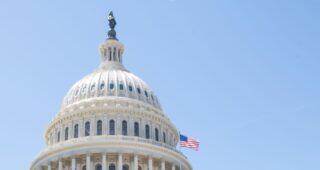The U.S. Should Continue Its Fight Against AIDS in Children
The return on investment in a foreign-aid program has been high, in diplomatic as well as humanitarian terms.
Early in his tenure, President George W. Bush did something that would become an important footnote of his foreign-policy legacy. With strong backing from the faith community, he launched the U.S. President’s Emergency Plan for AIDS Relief (PEPFAR) in 2003. He announced the initiative in his State of the Union Address, saying that “seldom has history provided a greater opportunity to do so much for so many.” To an American audience, he methodically laid out the tragedy of AIDS in Africa.
It is no exaggeration to say that this one foreign-policy program, which enjoys robust bipartisan congressional support, has saved millions of lives and restored hope and vitality to millions more. PEPFAR’s story, which is still unfolding today, is instructive as observers in Washington assess the Trump administration’s proposed budget and the reflex to pull back on foreign aid.
Indeed, PEPFAR is a standout example of how to achieve great things through strategic U.S. foreign-assistance investments — and of how public–private partnerships can wed the efficiencies of the private sector with the scale and reach of the public sector. By maintaining the program’s funding — something we both advocate — the United States and this administration will be well positioned to celebrate a historic public-health achievement: the end of the AIDS epidemic for an entire generation of children.
The rollout of PEPFAR nearly 15 years ago was swift and efficient. The program quickly scaled up effective HIV-prevention and -treatment programs through non-governmental organizations, but also by partnering with thousands of faith-based organizations that were already providing extensive health services across Africa. Since PEPFAR’s creation, the number of new infections in children worldwide has declined nearly 70 percent, and nearly 2 million HIV-positive mothers have given birth to babies who are HIV-free. Millions of HIV-infected adults gained access to life-saving medications and were able to return to healthy and productive lives, almost overnight.
Many Americans remember the work of Elizabeth Glaser, who in the 1980s unknowingly passed HIV to her two children. Sadly, her daughter Ariel died at age seven in 1988, but her son Jake lives a full, healthy, and active life today. Elizabeth lost her own battle with HIV in 1994, spending her final years as a leading national advocate for children with HIV. Through this work, she laid the groundwork for the virtual elimination of mother-to-child HIV transmission in the United States.
Few Americans at the time understood the toll that HIV/AIDS was taking in the developing world. By the early 2000s, AIDS was a crisis of enormous proportions in sub-Saharan Africa, where approximately 30 million people were living with the virus. Fourteen hundred babies were born HIV-positive each day, their mothers left with no treatment options to save their own lives or those of their children.
Churches and the faith community often shouldered much of the burden in Africa, serving on the frontlines of the epidemic to provide comprehensive support and care to those living with the virus and to the families left behind in its wake. Notably, since the beginning of PEPFAR, almost $2 billion in U.S. funding has gone to faith-based organizations. Much of that went toward life-saving care, services to prevent mother-to-child transmission, and support programs for millions of children infected with and affected by HIV.
For years, the virus had been ravaging the African continent and destabilizing some of the world’s poorest and most vulnerable communities. PEPFAR drastically reduced HIV/AIDS-related mortality and morbidity and rapidly expanded access to anti-retroviral treatments for millions of men, women, and children in countries where virtually no response to the epidemic existed just a decade earlier.
But PEPFAR’s value extends beyond the humanitarian. A 2015 report by the Bipartisan Policy Center noted that PEPFAR served as an effective diplomatic tool, as people in the program’s target countries saw the United States in a better light. The program has also shown an exemplary return on U.S. investments, as funds are distributed efficiently and strategically to achieve the greatest impact.
Even so, unfinished business remains. Today, 1.5 million HIV-positive women become pregnant each year, and 400 children are infected with HIV every day. Only about half of the 1.8 million children living with HIV have access to the medications they need, and AIDS remains the leading cause of death among adolescents ages ten to 19 in Africa. Sustained commitment, investment, and prioritization are critical to driving continued progress and overcoming these final hurdles.
Steep reductions in U.S. foreign-assistance funding jeopardize the goal of ending pediatric AIDS in our lifetime. Significant cuts would inevitably roll back the dramatic progress brought about largely by both the generosity of the American people and the global faith community.
Washington Post columnist Michael Gerson visited Africa as a policy adviser shortly after PEPFAR was unveiled. Years later he remarked that the program “existed entirely because of a willing leader, a creative policy team, a smattering of activists, and a vast, bleeding need.”
That bleeding need is still there, and our hope is that President Trump, too, will stand behind a policy untethered to politics, so we can defeat a disease unbound by borders. With continued political and financial commitment, this could and should be the administration that can celebrate the end of AIDS in children.
Charles Lyons is the president and CEO of the Elizabeth Glaser Pediatric AIDS Foundation, the world’s leading organization committed to the global elimination of pediatric HIV and AIDS. Richard Stearns is the president of World Vision U.S. and the author of The Hole in Our Gospel.
This article was originally publihsed by the National Review.
Chip Lyons (EGPAF) & Richard Stearns (WorldVision)
Policy & Advocacy



